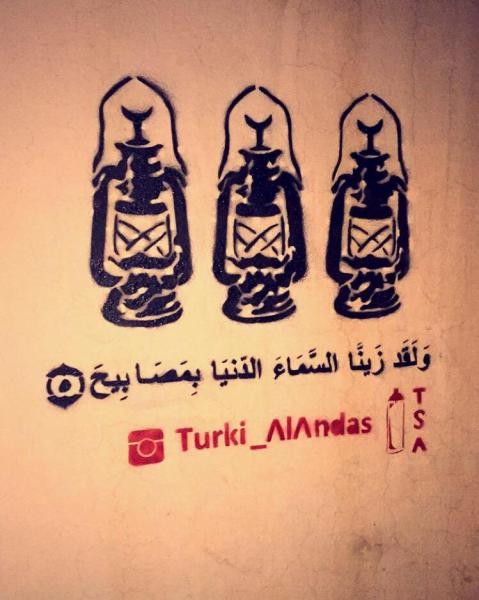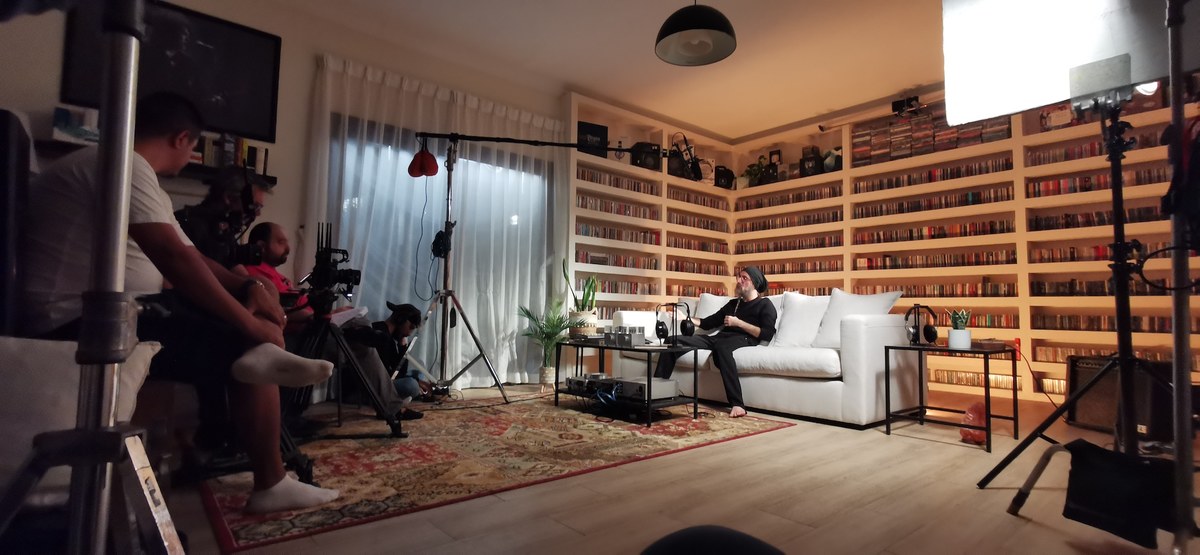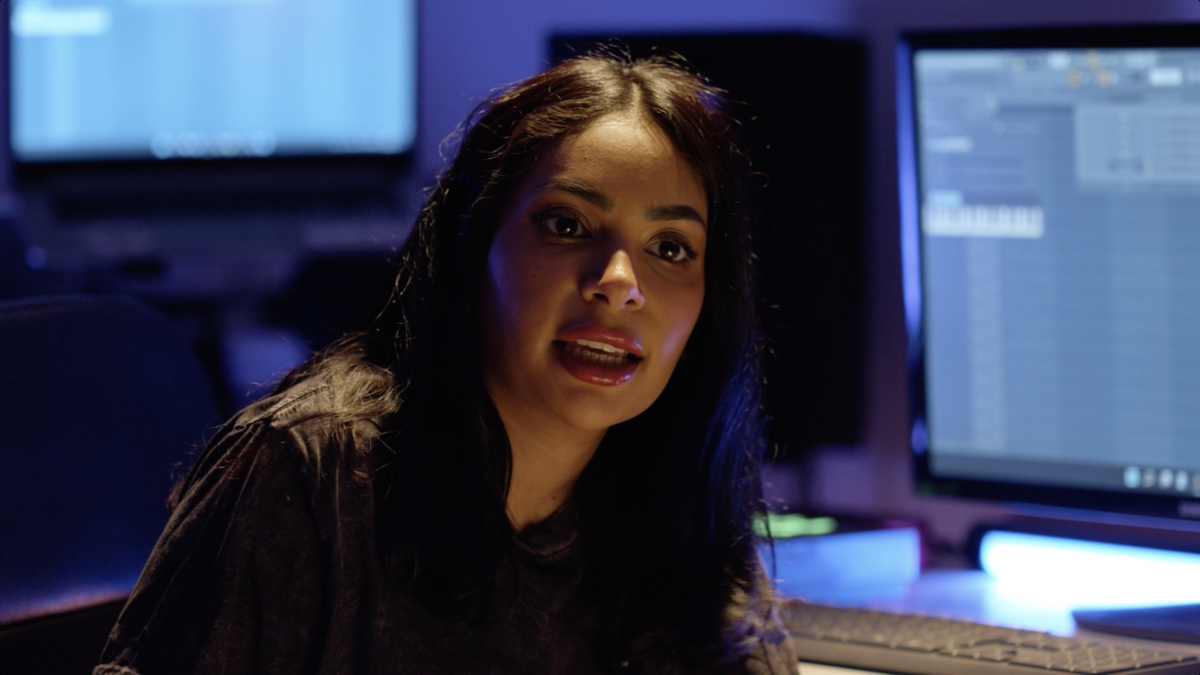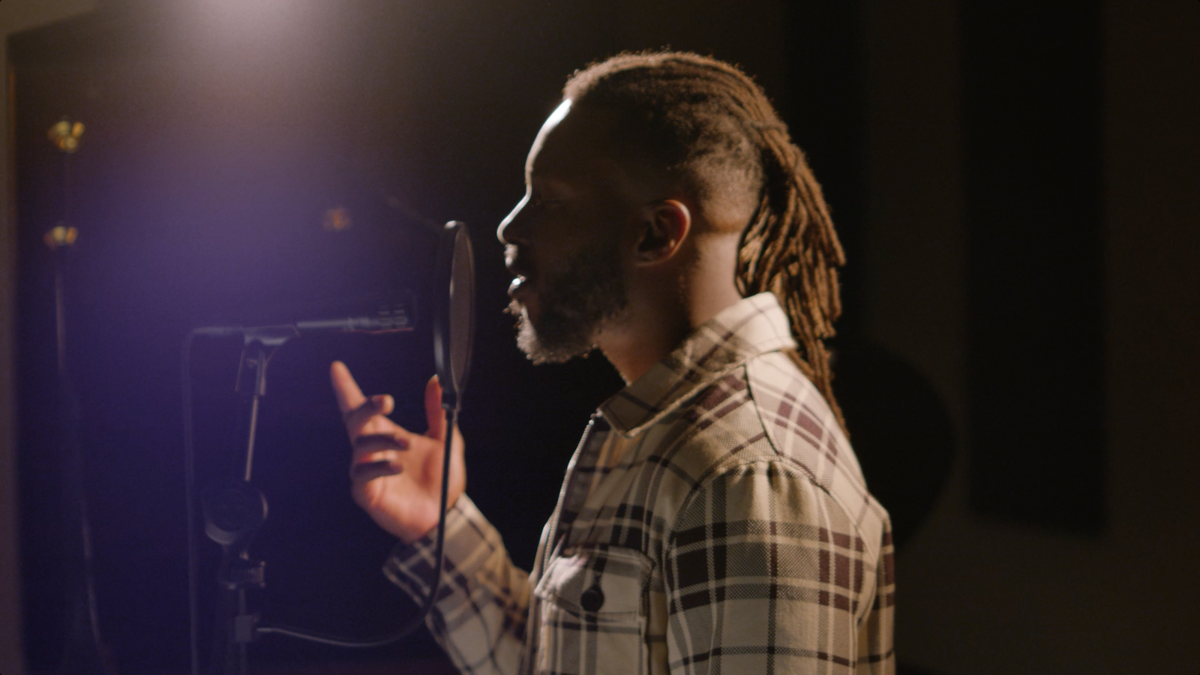We’ve seen this countless of times, graffiti scribbles on a school wall, buildings, houses and street corners. Many find graffiti bothersome, ugly, disorganized, purely immature and downright disrespectful … But can one really judge the art behind this act of so-called vandalism? Graffiti is an art form that is difficult to decipher and understand but it’s not that complicated as trigonometry, all there is to it is an artistic mirror of the doer’s mindset and need. Graffiti can come in so many forms; all we can say is that it’s street art. Some are grand and combine half a dozen colors with inscriptions yet others can be simple and straight forward. Turki Al-Andas took that straight forward stance in graffiti, he’s a graffiti artist with an intent to beautify his city, Riyadh. Every now and then, you’ll find graffiti in the form of a phrase accompanied by a structure of some sort, that’s Turki’s art.
With 100 graffiti spread all over the city of Riyadh, Turki doesn’t simply choose a random picture or location, the process takes a lot of him. In his own words, there are three phases that he goes through. The thought of a specific graffiti comes along after experiencing something personally, whether it’s a phrase from the Qur’an or Sunnah, a paragraph he read in a book, a picture he’s seen in a magazine or television or a light bulb over the head thought. He chooses the picture that he thinks would go along with a phrase of his choosing that suits the accompanying picture, then comes the hard part, perfecting that image on stencil and making sure that it’s preserved against the environmental effects. The locations can be somewhat random but he smartly chooses an area where his graffiti is needed.
“I love my city, no wait; I feel a passion toward my lovely city of Riyadh. It’s large, modern with beautiful sky scrapers, roads, malls, and structures but if you take a side road into one of the alleyways, that beauty disappears all together. That’s life; it’s not purely beautiful all around. I want to beautify my city; it’s my gift to it. The locations I choose to graffiti are helping bring some joy, wisdom and a sense of art therapy.”
Each stenciled graffiti image speaks a story, each inspired by something the artist felt, as with most artists. But what makes Turki’s graffiti stand out is the simplicity of a picture with an intensity of a phrase. The 21-year-old native of Riyadh includes some mischief and humor in his graffiti like the mouse holding an ax waiting for the cat by the corner, an ode to Tom and Jerry of course. To create a stenciled image, the young artist starts off with doodles and experimenting on a regular piece of paper until he gets the image he wants just right. The next phase is to transfer that image to a much larger hard paper and create the right cutouts as well as the phrase he’ll be using with it. “I’ve never had a strong background in art, but I’ve loved it as a child and now as an adult I went back to finding the method that suited me best. My parents were always an encouragement and so that’s how my trial and error stage never ceased. It’s natural to make mistakes but I’ll keep learning until I get it right. I might not see the flaw in one of my graffiti at first but someone might come and critique it for me and that’s how I learn.”
As for critique and praise, young Turki communicates mainly on his social media pages. Naturally not everyone would understand his way of art and offer different levels of advice and critiques, but many are in agreement that it brings joy to catch a glimpse of his work here and there in the streets of the capital. Many still think that his work isn’t beautifying walls, they believe in the opposite form, that graffiti is merely splashes of incoherent gibberish. Many call forth for the municipality to deal with his graffiti but as he recalls in a number of incidents with the local police and municipality workers, they’ve never stopped him per se. They were inquisitive and curious and after explaining, they would allow him to continue with his work. Al Andas believes they’ve understood his intent and thus allowing him to finish the graffiti he’d be working on.
“I am equally in the same position as the other graffiti artists who chose to write down their numbers or declare their love for person X, it’s the message that is different but graffiti is graffiti.”
Art will always be art, regardless of the misunderstandings, some see the beauty in it, and others don’t. It’s a personal perspective of each individual, but we can all agree that no matter what, there should always be respect toward the artist and his portrayal of it. For more on Turki’s graffiti, follow him on his Instagram and Twitter accounts: Turki_Alandas.
—
Email: [email protected]
A gift in the form of graffiti
A gift in the form of graffiti

Hoor Al-Qasimi appointed artistic director of the Biennale of Sydney

DUBAI: The Biennale of Sydney announced this week that Emirati creative Hoor Al-Qasimi will become its artistic director for 2026.
The 25th edition of the biennale will run from March 7 to June 8.
Since its inception in 1973, the biennale has grown to become one of the longest-running exhibitions of its kind and was the first biennale established in the Asia-Pacific region.
Al-Qasimi created the Sharjah Art Foundation in 2009 and is currently its president and director. Throughout her career, she acquired extensive experience in curating international biennials, including the second Lahore Biennale in 2020 and the UAE Pavilion at the 56th Venice Biennale in 2015.
In 2003, she co-curated the sixth edition of Sharjah Biennial and has remained the director of the event since.
Al-Qasimi has been president of the International Biennial Association since 2017 and is also president of the Africa Institute. She has previously served as a board member for MoMA PS1 in New York and the UCCA Center for Contemporary Art in Beijing, among other roles.
She is also the artistic director of the sixth Aichi Triennale, scheduled to take place in Japan in 2025.
Saudi pop star Mishaal Tamer feels ‘honored and grateful’ ahead of sold-out London gig

- Singer tells Arab News his fans in the city have a special place in his heart but he owes his success to people all over the world who have embraced his music
- He says his debut album, “Home is Changing,” out in October, is a tribute to the changes and reforms that have swept through the Kingdom in recent years
LONDON: Saudi singer Mishaal Tamer said he feels honored to be performing his first headline show outside Saudi Arabia in London and is grateful to his fans there for their support.
Speaking to Arab News ahead of his sold-out gig on Friday at Camden Assembly, a live music venue and nightclub in Chalk Farm, Tamer said his fans in London will always have a special place in his heart.
“The people attending the show in London have been with me from before the starting line and I really appreciate that,” he said of the 220 people who will attend the event. “I will love those people forever and they will be in my heart forever.”
Tamer also thanked his fans in Saudi Arabia and elsewhere in the world, saying he owes his success as an independent artist to them.
“The kids that are back home and the ones abroad that have found me have been supporting me,” he said. “This would be impossible without them. I am grateful to the fans for listening to the music and sharing it.
He told how he was approached by two fans in a restaurant after arriving in the UK, which helped him realize how his profile was growing.
“One of them was Saudi, the other wasn’t,” Tamer said. “When I looked at that, it made me realize that not only was this bigger than I expected for me, as an artist, but that what we’re doing is bigger than me.”
His debut album, “Home is Changing,” is due for release in October and he said it is a tribute to the changes and reforms that swept through the Kingdom in recent years.
“There are so many opportunities that keep popping up, so many cool new things,” he added. “People have the freedom and creativity to make the world around them and the environment around them, to shape it into what they see in their heads.
“It feels almost like every other country is decaying whereas the Kingdom is growing and that feeling makes me proud.”
The evolution of Saudi Arabia “sets an example of always being hopeful for the future and having a positive attitude,” Tamer said. “And I think the optimism that we have right now in the Kingdom is a beautiful thing.”
Saudi filmmaker Abdulrahman Sandokji’s ‘Underground’ discusses the Kingdom’s music scene

- ‘Unfolding the unseen is my thing,’ says Abdulrahman Sandokji
DUBAI: “In film school, they tell you that your first film should be a documentary — train in a simpler form, then go to fiction,” says Saudi filmmaker Abdulrahman Sandokji. “So, naturally, I started with documentaries. But I got hooked.”
Over 15 years later, Sandokji still hasn’t moved on to fiction. Not that that’s an issue for him. His documentaries — produced by the company he founded, Basar Media — have proven immensely satisfying.
“A fiction film can take one or two years to shoot. I have no patience with waiting days and days to shoot one scene. I want things faster and more surprising,” he tells Arab News.

“And (documentaries) are honest. You’re talking about real stories. Unfolding the unseen is my thing, you know? I want to go into these deep places and show them to people,” he continues. “It’s a way to understand people, to really see people. To pick a flower from lots of beautiful gardens and plant them in your own garden. It’s more of a journey of discovery for me, you know? That’s what I love about documentaries.”
Sandokji’s breakthrough came with his 2014 film “Phosphine,” which he describes as a “Michael-Moore style” investigative documentary. It explored how the titular chemical — a potentially deadly respiratory poison — had been used (out of ignorance rather than malice) in homes to kill cockroaches, rats and other pests. While the actual occupants had been told to leave their apartments for five or six days, their neighbors were not, and the odorless gas killed them.
Sandokji put his documentary up on YouTube. It got 5 million views in five days, he says, adding that, at the time, he and his colleagues were delighted if they got 100,000 views on any of their videos, because they “weren’t funny — they weren’t comedies.” But “Phosphine” ended up making a difference to society, as well as to Sandokji’s career.

“We were on TV shows and talk shows — we were overwhelmed. Lots of social movement happened and governmental sectors held very urgent meetings about this substance. The Ministry of Health set up a hotline about it,” he says. “That was when I thought, ‘OK. Maybe this is your thing. Being a voice for those who want their voices to be heard.’”
Unlike “Phosphine,” Sandokji’s latest doc, “Underground,” is not a “tragic story.” But, once again, it was a “journey of discovery” for him — one that delves into the Kingdom’s burgeoning alternative music scene.
The idea — as for many of his films — was not Sandokji’s own. “When I analyze myself, I’m more of a person who receives an idea and then gets to enlarge it,” he says. “When I generate an idea myself, people go, ‘Mmm. No.’” He laughs. “They’ll go, ‘How about this idea instead?’ I’m like the gas — just throw the spark on me and I’ll explode, you know?”

The “spark” for “Underground” came from a friend, Tamer Farhan. “He’s passionate about underground music. He knows all these artists,” Sandokji says. “And he opened the window to me and said ‘Come and have a look.’”
What Sandokji found was a wealth of talent and experience that has largely gone unnoticed in Saudi Arabia — understandably, given that until recently live music was largely outlawed in the Kingdom, and music that wasn’t commercial Khaleeji pop or classical Arabic fare was frowned upon.
“These people are good people,” says Sandokji. “Over the years people talked about the music underground as this place with drugs and all this prohibited stuff. But no. They are nice. They have feelings. They love their music and they’re passionate and they’re kind.”
That passion shines through in “Underground,” whether from veterans such as metal band Wasted Land’s frontman Emad Mujallid or relative newcomers such as DJ Cosmicat (Nouf Sufyani) and Salma Murad. All the artists involved are given the opportunity to discuss their craft and love for music in depth, and to play some of their music live.

“(The songs) are not recorded and synced,” Sandokji says. “I wanted to show the audience how talented they are.”
So far, that audience is whoever attended the premiere on the opening night of the Saudi Film Festival on May 2 — another landmark for Sandokji, he explains. “Usually they choose fiction films — good fiction films — for the opening. I was always watching them thinking ‘When am I going to make a movie that could be screened in the opening? I’m a documentary maker, nobody would give me that chance.’ But it happened.”
And he believes “Underground” has the potential to grab international attention. It’s already been submitted for consideration at several large festivals, but the main aim since he started shooting it in 2022, Sandokji happily admits, has been to get the film on Netflix. There are also discussions underway about turning it into a TV series.
“It’s something people will want to know more about, I think,” he says, before citing the words the movie concludes with, when Murad is discussing what music means to her: “It’s powerful. It’s beautiful.”
“When Salma said that, I had goosebumps,” Sandokji says. “I thought, ‘Yes! These are the words the movie has to end with.’ Music is powerful; it can make you very strong, it can make you very weak… it’s magical.”
El Seed launches Tunisian olive oil brand Tacapae with artworks for bottles

DUBAI: French-Tunisian artist El Seed’s take on Arabic calligraphy (sometimes referred to as ‘calligraffiti’) has embellished favelas in Brazil, marginalized buildings in Cairo, and the Saudi desert. He is known for working with local communities to share messages of human connection, based on quotes from influential writers and philosophers.
In a departure from his usual large-scale artworks, the artist recently launched his most intimate endeavor to date. The project is called “Tacapae” and consists of olive oil-filled bottles decorated with El Seed’s swirling calligraphy. The name of the brand is inspired by the ancient Greek name of the artist’s hometown, Gabes, in southern Tunisia, from where the olive oil is sourced.

“I didn’t want to call it ‘El Seed Olive Oil’ because I don’t link the oil to myself,” El Seed tells Arab News at his Dubai studio in Alserkal Avenue. “I’m the founder, but the goal is to have a bottle designed by other artists every year. It’s a kind of partnership.”
El Seed explains that his cousin informed him of a plot of land for sale in Gabes. “And it happened that the olive trees of this land were planted by my great-grandfather,” he says.
El Seed purchased the land and its trees now provide the oil for Tacapae. A total of 31 bottles (a tribute to the land’s original 31 trees) were personally hand-finished by the artist himself.

The most powerful aspect of the ceramic, handmade bottles is the quote El Seed used. Translated into Arabic from a quote by 20th-century US novelist John Dos Passos, it reads: “You can snatch a man from his country but not the country from a man’s heart.”
Those words have resonated with El Seed his whole life. “Nobody can take away from you all the memories that you carry for a particular place,” he says. “I grew up in France, I live in the US and Canada and I spend some time in the Middle East, but my main focus is in Tunisia. I carry it with me.”
The story behind Saudi artist Alia Ahmad’s alluring abstracts

- Ahmad is garnering international attention, with two solo exhibitions in Europe
RIYADH: Hanging at the Diriyah Contemporary Art Biennale in Riyadh is a large canvas titled “Alwasm,” a 2023 painting by Saudi artist Alia Ahmad. It’s an instant showstopper. Guests on the opening night of the event, which runs until May 24, gathered around the painting, which was inspired by Wadi Hanifah in the Najd region of Riyadh, which is where the biennale is being staged. Commissioned for the event, the painting’s alluring warm tones and lively hues capture the titular period between October and December when the weather becomes cooler and there is respite from the arid desert heat.
Ahmad is on a roll. Since graduating from London’s Royal College of Art with a Master’s in 2020, the 28-year-old Riyadh-based painter has staged several solo exhibitions in her home country and has increasingly garnered international attention for her abstract expressionist canvases that depict the natural and urban landscape of her home country. Ahmad says she considers paintings “social spaces” as well as “blueprints.”

“These paintings represent my version of the landscape,” Ahmad tells Arab News. “They include elements that may be references to birds or various color palettes that aren’t necessarily found in the landscape, but that represent how I view it. I’m addicted to incorporating my imagination.”
The desert landscape, she stresses, “is not necessarily dry or empty. It has so much more.” And that is what she captures in the lush, lyrical brushstrokes of her abstract works, which are filled with references to local culture. “The traditional Arab bedouin dress is filled with color. As are the tents,” she says. “Women here have traditionally embellished their gowns. Where does this sense of vibrant creativity come from? The color and playfulness we imbue our traditional dress and items with comes from the landscape.”
Ahmad recently staged her first solo exhibition in Europe. “Terhal Gheim (The Voyage of the Clouds)” runs at White Cube in Paris until May 18.
On March 7 this year she sold her first work at auction at the Phillips 20th Century & Contemporary Art sale in London. Her painting “Malga — The Place in Which We Gather” sold for four times its estimate, bringing in a remarkable £101,600 (roughly SAR475,825).

And on May 2, another solo exhibition — “Thought to Image” — opened in London at Albion Jeune. Running until June 12, the show presents Ahmad’s alluring abstract landscapes, inspired by the hues of traditional textiles created by Sadu weavers of Bedouin tribes and the Arabic calligraphic script known as khatt.
“Much of my inspiration comes from textiles,” she explains. “At one point I was obsessed with buying pieces of fabric and making collages.”
She also used to draw stick-figure cartoons as a child, she adds. Those amateur drawings were works in progress — an aspect Ahmad continues to enjoy in her practice. “I loved the idea of having a drawing in progress to then fill in the blanks of what the character might look like later,” she says.
Ahmad’s paintings today are an amalgamation of various aspects of her homeland — its rich natural environment from the desert to the lush palm trees and other vegetation, local dress, jewelry and animals. She brings all of them together to depict in colorful abstract forms the richness of Saudi heritage, particularly that of her home region of Najd.
Her works, as international gallerists and collectors have found, are rife with specific local details that connect in some way with people across the world, even if only by piquing their curiosity about a country that has only recently really opened up to visitors.
Ultimately, Ahmad’s paintings serve as a unique reference point during a time of monumental social and economic change in the Kingdom, revealing and documenting a moment of both transformation and a desire to retain and promote Saudi’s rich heritage.
Her imaginary landscapes also include flattened perspectives, nods to her previous training in digital graphics. They reflect the futuristic visages of the modern world coupled with the beauty of the undulating curves of the desert landscape and the colorful attributes of Arabian culture.
Each painting takes the viewer on a voyage into a vibrant abstract world that echoes aspects of everyday reality.
As Ahmad puts it: “They are all playful paintings and I make sure that each work and each show I stage retains that aspect of curiosity.”














